Chapter 18.43
CITY CENTER DISTRICTS
Sections:
Article 1. Applicability and Administration
18.43.030 Existing development.
18.43.040 Amendments or additions.
Article 2. Zones and Standards
18.43.050 Regulating plan established.
18.43.070 Requirements for all property.
18.43.080 Requirements by zone.
18.43.090 Development standards – Transit neighborhood zone (“TN”).
18.43.100 Development standards – Urban office zone (“UO”).
18.43.110 Development standards – Urban neighborhood zone (“UN”).
18.43.120 Allowed land uses and permit requirements within city center zoning districts.
18.43.135 City center district art program.
Article 3. Walkable Block Standards
18.43.140 City center scale, intended physical character streetscapes.
18.43.150 Street dedications and improvements required.
Article 4. Building Frontage Standards
18.43.180 Frontages types and standards.
18.43.190 City center-scale frontage.
18.43.210 Addition of building frontage type.
18.43.220 Requirements by zone.
18.43.230 Shopfront frontage standards.
18.43.240 Forecourt frontage standards.
18.43.250 Terrace frontage standards.
18.43.260 Stoop frontage standards.
18.43.270 Parking court standards.
Article 1. Applicability and Administration
18.43.010 Purpose.
This chapter contains the integrated zoning standards that implement the city center community plan, and is referred to as the “city center code.” Where there is a conflict between the city center code and the city center community plan, the city center code shall govern.
It is the purpose of the city center code to protect and promote the public health, safety, comfort, convenience, and general welfare of the community and implement the general plan for the property identified in Figure 18.43.010.
The city center code implements the intended residential densities and nonresidential intensities identified in the general plan and the city center community plan. The development standards of this chapter reflect the physical character envisioned by the city center community plan. Therefore, the city center code does not use or need standards related to dwellings per acre or standards for floor area ratio. Compliance with the city center code will achieve the policy direction.
The city center code is also intended to implement the city center-scale environment envisioned in the city center community plan, namely:
(a) Buildings placed near to, facing and defining the streets.
(b) Buildings with visually balanced and detailed facades, and pedestrian-oriented entries, frontages and signage.
(c) Buildings that are composed of volumes similar in scale and materials to those found in metropolitan city centers, such as concrete, glass, masonry and wood buildings and pedestrian-friendly streetscapes, with the following form:
(1) Buildings that are larger than houses, occupying some or all of a block, and intended to accommodate several stories;
(2) Buildings with urban frontages and ground floors that range in overall height, with portions of buildings that provide massing variation adjacent to smaller scale neighborhoods; and
(3) Streetscapes that include generous sidewalks, steady rows of street trees, awnings and/or building galleries to shade and define the pedestrian way, and landscape, lighting and signage that enhance the street as a comfortable and visually interesting environment for strolling, shopping and visiting.
Figure 18.43.010 City Center Boundaries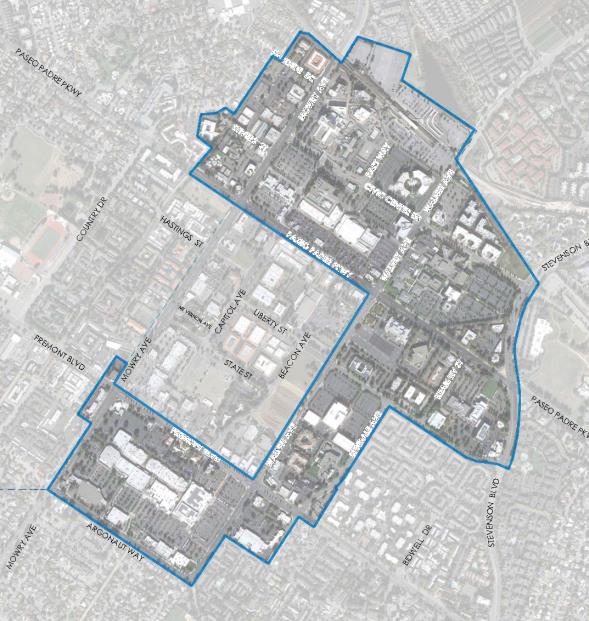
Parcels within the boundary are subject to the city center code.
(Ord. 15-2015 § 2 (Exh. B), 6-2-15.)
18.43.020 Administration.
(a) Regulations Generally. The regulations contained in this chapter apply to all property within the code boundaries identified in Figure 18.43.010, in conjunction with the guidelines contained in the city center community plan.
(b) Relationship of City Center Code to FMC. All applicable provisions of this title and the Fremont Municipal Code (FMC or code) that are not specifically replaced or identified as not applicable continue to apply. If a conflict arises between the requirements of the city center code and the rest of the code, the requirements of the city center code shall prevail.
(1) Compliance with the City Center Code. No permit shall be issued by the city unless the proposed project complies with all provisions of this chapter, including any required findings, conditions of approval, and all other provisions of law, as applicable.
(2) Legal Parcel. The site of a proposed land use, development, modification or other improvement subject to the city center code shall be on a parcel(s) legally created in compliance with the Subdivision Map Act and Title 17 (Subdivisions). Parcels created after the adoption of the city center code that consist of an entire block are subject to the requirements of Table 18.43.140 for the applicable zone.
(3) Minimum Requirements. The provisions of the city center code are minimum requirements for the protection and promotion of the public health, safety, and general welfare. When this chapter provides for discretion on the part of a city official or body, that discretion may be exercised to impose reasonable conditions on the approval of any project proposed within the boundaries of Figure 18.43.010.
(4) Historic and Cultural Resources. Properties identified by the city as historically or culturally significant, or potentially significant, shall comply with applicable provisions of Chapter 18.175.
(5) Design Review Process. All requests for new structures or modifications to existing structures shall obtain a design review permit (DRP) under Chapter 18.235.
(6) Parking within City Center. Property within the city center code boundaries is intended to generate and maintain the envisioned physical environment and land use activity through a shared parking approach for nonresidential parking. The intent is to allow for each property to generate building area, land use activity and open space while grouping the parking facilities in strategically dispersed locations. This approach is for the purpose of encouraging walking between businesses and destinations and relieving individual properties from providing potentially duplicative parking. Therefore, properties shall be allowed to share parking pursuant to the parking requirements identified in the applicable zone.
(7) TOD Overlay District (Chapter 18.152). The city center code implements the standards of the adopted transit-oriented development (TOD) overlay district into applicable provisions of the city center code. Notwithstanding Section 18.152.020(c), the provisions of this chapter shall govern where a conflict exists with Chapter 18.152. (Ord. 15-2015 § 2 (Exh. B), 6-2-15.)
18.43.030 Existing development.
(a) Effect on Existing Development and Land Uses.
(1) Planned districts existing on the date of adoption of this chapter may continue in accordance with their approved development rights and shall not be considered legal nonconforming uses. Additional development within such planned districts that is not vested must conform to the requirements of this chapter.
The future use of planned district zoning is prohibited within the boundaries of the city center code.
(2) The owner or occupant of land or buildings within the city center code boundaries identified in Figure 18.43.010 shall comply with the provisions of this chapter; provided, however, that buildings, structures, site improvements, landscaping or uses lawfully constructed or established prior to the effective date of this chapter that do not comply with the provisions of this chapter shall be deemed legally nonconforming and subject to the provisions of Chapter 18.180 (Nonconforming Uses and Structures) except as provided in subsection (a)(2)(D) of this section (Repair, Maintenance and Incremental Compliance).
Such buildings, structures, site improvements, landscaping or uses will only be required to comply with the city center code when any of the following occur and only with regard to the portion of the site or building that is the subject of the application and will undergo changes if the application is approved:
(A) Blocks. Existing blocks or parcels that do not conform to the requirements of Table 18.43.140 shall be made to conform when any of the following apply:
(i) An existing block is proposed to be modified in shape or size other than changes to ingress, egress, curbs, sidewalks, and other similar modifications that do not modify a block’s overall shape and size;
(ii) A new block is proposed.
(B) Site Improvements.
(i) New driveway along primary or secondary street frontage;
(ii) Modification or relocation of driveway along primary or secondary street frontage;
(iii) New parking area;
(iv) Expansion of parking area within 50 feet of primary or secondary street frontage.
(C) Buildings, Additions, and Frontage.
(i) Additions within 50 feet of primary or secondary street frontage, except as provided in subsection (a)(2)(D) of this section:
a. For buildings less than 5,000 square feet: cumulative expansion exceeding 25 percent.
b. For buildings between 5,000 square feet and 30,000 square feet: cumulative expansion exceeding 20 percent.
c. For buildings more than 30,000 square feet: cumulative expansion exceeding 15 percent.
(ii) A new building is proposed, except as provided in subsection (a)(2)(D)(ii) of this section.
(D) Repair, Maintenance and Incremental Compliance.
(i) Repair and Maintenance Allowed. Repair and maintenance of legally established improvements and buildings do not require compliance with this chapter.
(ii) Incremental Compliance. Notwithstanding subsection (a) of this section, incremental changes may be made to legally established improvements, and buildings, without complying with this chapter; provided, that they are consistent with the long-term vision of the city center community plan, as determined by the zoning administrator. (Ord. 15-2015 § 2 (Exh. B), 6-2-15.)
18.43.040 Amendments or additions.
Over the course of implementing the city center code, it may become necessary or desirable to include additional street or building frontage types in the city center code. Such additions shall be processed pursuant to the requirements of Chapter 18.225 and the following:
(a) Addition of Street Type.
(1) A written statement identifying that the proposed type is not similar to any of the allowed types;
(2) A diagram showing the proposed type in plan and section to identify the proposed configuration and its key elements.
(b) Addition of Building Frontage Type.
(1) A written statement identifying that the proposed type is not similar to any of the allowed types in Table 18.43.220;
(2) A diagram showing the proposed type in plan and section to identify the proposed configuration and its key elements;
(3) At least three examples of the proposed type in its intended physical context. (Ord. 15-2015 § 2 (Exh. B), 6-2-15.)
Article 2. Zones and Standards
18.43.050 Regulating plan established.
(a) Purpose of Regulating Plan. The regulating plan, Figure 18.43.050, identifies the applicable zones and requirements for property and rights-of-way subject to the city center code.
(b) Implementation of Zones through Land Use and Development Standards. Each zone identified on Figure 18.43.050 contains standards to implement the corresponding part of the community vision as described in the city center community plan, including:
(1) Intended physical character: streetscapes/public realm, open space, buildings, and frontages, and
(2) Land use, development standards, and parking.
(c) Street Standards. Figure 18.43.050 identifies the street types for existing and new streets to support the zones established by this chapter. Existing and intended rights-of-way are subject to the street types in Chapter 4 of the city center community plan, and Article 3, Walkable Block Standards.
Figure 18.43.050 Regulating Plan and Zones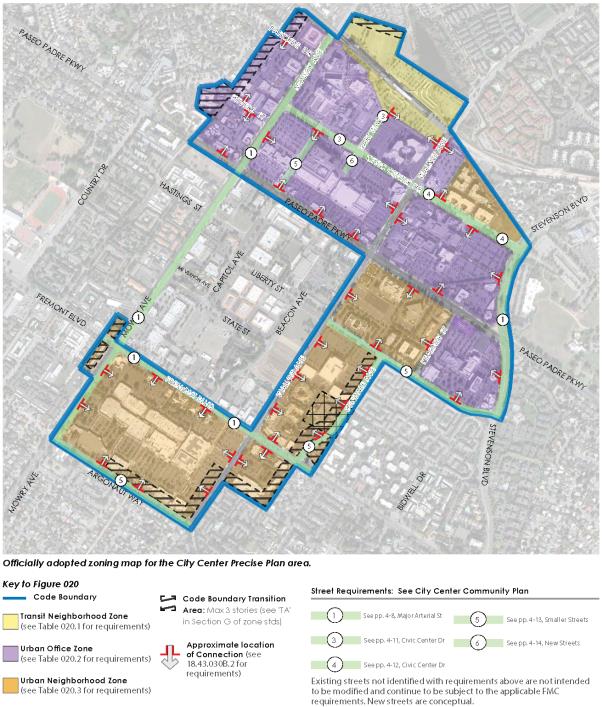
(Ord. 15-2015 § 2 (Exh. B), 6-2-15.)
18.43.060 Zones.
The properties within the boundaries of Figure 18.43.050 are regulated by one of the following zones:
(a) Transit Neighborhood (TN). See Section 18.43.090.
(b) Urban Office (UO). See Section 18.43.100.
(c) Urban Neighborhood (UN). See Section 18.43.110. (Ord. 15-2015 § 2 (Exh. B), 6-2-15.)
18.43.070 Requirements for all property.
(a) General Requirements. All property subject to the city center code shall comply with the following provisions as applicable pursuant to Section 18.43.030:
(1) The standards of this chapter and those specific standards of the applicable zone identified in Figure 18.43.050;
(2) The requirements for processing of applications in Chapter 18.235 (Design Review Permits);
(3) Section 18.183.020 (When off-street parking is required);
(4) Sections 18.183.110(c) through (k) (Development and maintenance of parking and loading areas);
(5) Section 18.183.120 (Parking spaces accessible to disabled people);
(6) Section 18.183.172 (Car share and electric vehicle spaces);
(7) Section 18.183.174 (Electric vehicle charging stations);
(8) Section 18.183.175 (Tandem parking spaces for residential uses);
(9) Section 18.183.176 (Mechanical parking systems);
(10) Section 18.183.178 (Parking garages – Above and below grade).
(b) Open Space Requirements. As required by the building placement standards of the applicable zone, open space shall be provided as follows:
(1) Required Open Space. Required open space shall be distributed throughout the site as follows:
(A) At least 50 percent of required open space is to be adjacent to a streetscape with a minimum dimension of 50 feet in width along the streetscape and shall be accessible to the general public;
(B) No more than 25 percent of required open space may be on the roof(s);
(2) Required Private Open Space. Required private open space shall be provided in the form of balconies, roof decks or ground floor patios as follows, unless otherwise specified through review and approval of a design review permit (DRP):
(A) At least 50 square feet per dwelling;
(B) If the private open space is adjacent to a sidewalk or other circulation path, the private open space shall be defined by a low wall and/or a terrace which may include a porch;
(C) Common open space may be substituted for the required private open space by a ratio of 2:1 (e.g., 100 square feet of common open space may be substituted for 50 square feet of required private open space);
(3) All open space shall be designed to enhance or complement the architectural design and ground floor frontages of adjacent buildings;
(4) All open space shall be designed to generate the urban environment envisioned in the city center community plan;
(5) All open space shall be designed to not create a security or physical hazard to pedestrians or motorists;
(6) All open space shall be designed to provide visual interest year-round;
(7) All open space shall be designed to utilize water conservation methods and drought-tolerant planting.
(c) Transportation Demand Management. New high intensity development shall include measures to promote usage of alternatives to automobile travel and reduce total vehicle trips and vehicle trips during peak hours through site design measures and participation in an established transportation demand association supporting programs for enhanced transit ridership, biking, and walking.
(d) Terminated Vista Requirements. When determined by staff to be located at a terminated vista, areas of a new building, or site or building proposed to be modified, shall incorporate a design that visually enhances this view, as determined by the city through the design review permit process in Chapter 18.235. Examples of such enhancement include additional detail on a portion of the facade, modulated building volumes, and the visual framing of an open space through the placement of facades.
(e) Right to Urban Core Operations. A variety of residential, business, cultural, civic, places of entertainment, and other uses that foster a vibrant, active urban environment are allowable within the city center zoning districts and may cause temporary inconvenience. Businesses and residential developments in the city center zoning districts are subject to the requirements of Chapter 18.188, which sets forth special noticing requirements intended to advise property owners, tenants and users of property of the inherent impacts and inconveniences associated with purchase, tenancy or use of property in the urban core.
(f) Private Storage. Each dwelling unit shall have an enclosed storage space located within the garage, patio, or deck area, unless an alternative space is approved through the design review permit approval. The storage space shall have an aggregate minimum of 100 cubic feet of storage area. If located within the patio or deck area, it shall not intrude into the minimum required open space. (Ord. 15-2015 § 2 (Exh. B), 6-2-15; Ord. 04-2016 § 8, 3-1-16; Ord. 02-2020 § 8, 1-14-20; Ord. 05-2021 § 12, 4-20-21; Ord. 07-2023 § 10, 12-5-23.)
18.43.080 Requirements by zone.
All requirements for each zone, including development standards, land use, and parking, are specified in Sections 18.43.090 (TN zone), 18.43.100 (UO zone), 18.43.110 (UN zone), 18.43.120 (land use), and 18.43.130 (parking). (Ord. 15-2015 § 2 (Exh. B), 6-2-15.)
18.43.090 Development standards: Transit neighborhood zone (“TN”).
(a) Intent and Purpose. The “TN” zone is applied to areas nearest the Fremont BART Station, intended to provide a variety of housing opportunities in large, multi-story buildings that may include limited neighborhood retail and services.
(b) Intended Physical Character – Buildings, Frontages. Buildings are primarily block-form with some townhouse buildings in areas of physical scale transition. Buildings are up to 12 stories by expressing a streetwall of up to four stories and tower-form volumes for stories five to 12. Buildings are primarily housing- oriented with limited nonresidential uses. Buildings are near or set back from the sidewalk to spatially define the streetscape. Massing is toward the front of buildings to spatially define the streets, provide service area in the rear, and promote compatibility with neighboring properties.
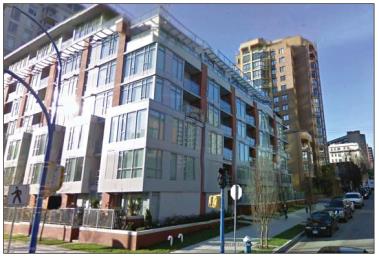
Mixed-use multi-story buildings at the sidewalk with limited nonresidential ground floor uses. Upper stories are massed as tower volumes to maximize views and generate a compatible streetwall for this area of the city center.
(c) Streetscape/Public Realm and Open Space. The streetscape is in support of pedestrian activity and consists of a range of frontages such as terraces, stoops, as well as limited shopfronts with wide awnings and shade trees. Wide sidewalks provide for comfortable strolling. Signage is limited.
Open spaces are urban and provide community gathering space in support of pedestrian activity and access to the Fremont BART Station and downtown.
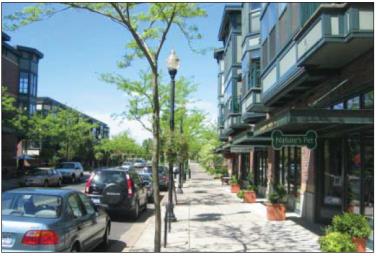
Sidewalks provide room for view of merchandise in shopfronts, displays and street furniture as well as for pedestrian comfort.
(d) Land Use Activity. Land use activity is primarily housing with limited neighborhood retail and commercial uses, relying on the adjacent urban office zone and the nearby downtown for larger retail, services, restaurants and entertainment.
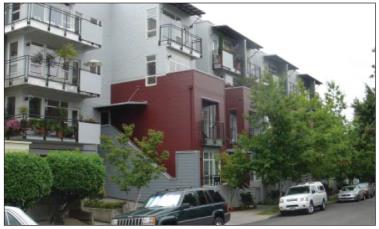
Transitions to neighboring, less intense areas outside of the city center are made through a combination of approaches that may involve townhouses and other walk-up access dwellings.
(e) Parking. Nonresidential parking is minimal and on-street. Residential parking is provided on the site of its building or remotely, as allowed.
(f) Building Placement.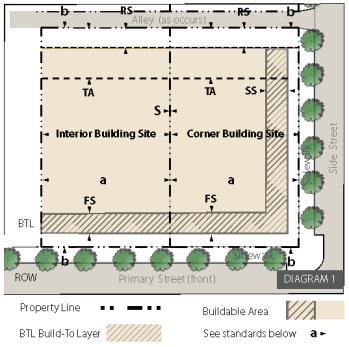
(1) One building shall be located within each building site per Diagram 1. One parcel may have several building sites per the standards below.
(2) Building facades along streets shall be located within the build-to layer per Diagram 1.
(3) Building facades shall extend along the frontages of the building site per subsection (h) of this section of these requirements.
(4) Projects with at least 20,000 square feet of building site area shall provide at least 15 percent on-site public and semipublic open space per Section 18.43.070(b). Projects shall provide private open space per Section 18.43.070(b)(2).
|
REQUIREMENT |
MIN. |
MAX. |
|
|---|---|---|---|
|
a |
Building site width |
200' |
400' |
|
b |
Building site depth |
100' |
400' |
|
FS |
Front setback (0 ft within 50 ft of corner) |
10' |
20' |
|
SS |
Side street setback (0 ft within 50 ft of corner) |
10' |
15' |
|
S |
Side setback1 |
0' |
n.a. |
|
RS |
Rear setback2 |
10' |
n.a. |
|
TA |
Setback within code boundary transition area per Figure 18.43.050 |
100': stories 4 through 12 |
|
1 Fire code – Building protection per local fire/safety code.
2 Where an alley provides vehicular access, minimum setback is five feet.
(g) Building Height and Massing.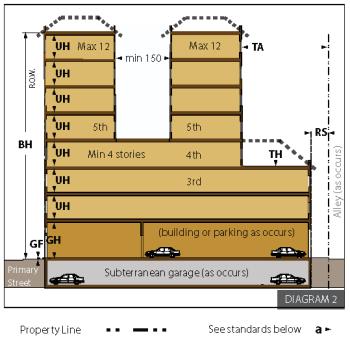
(1) Buildings shall comply with the standards table below, measured in stories and feet.
(2) For every 100 feet of building length, there shall be a plane-break along the facade comprised of an offset of at least five feet in depth by 25 feet in length. The offset shall extend from grade to the highest story. Stories five through 12 shall be expressed as towers at least 150 feet apart, as shown in Diagram 2. The maximum floor area for each story within a tower shall be approximately 10,000 square feet. These towers need not be rectangular, but may be designed to be of a variety of shapes or forms. Towers within 80 feet of a building edge shall be designed as distinct vertical forms from grade to the highest story.
|
REQUIREMENT |
MIN. |
MAX. |
||
|---|---|---|---|---|
|
BH |
Building height: stories and feet |
4/42 |
12/1451 |
|
|
TH |
Building height within the code boundary transition area per Figure 18.43.050 |
no min. |
3/36 |
|
|
GF |
Ground floor level above grade: |
nonresidential |
0' |
4' |
|
residential |
18" |
6' |
||
|
GH |
Height of ground floor |
16' |
none |
|
|
UH |
Height of upper story |
10' |
none |
|
|
TA |
Setback within code boundary transition area per Figure 18.43.050 |
100': stories 4 through 12 |
||
1 See Chapter 18.250 for the process and requirements to request increases in allowed building height. Architectural elements such as roofs, parapets, and finials are allowed up to 175 feet.
(h) Frontages and Encroachments.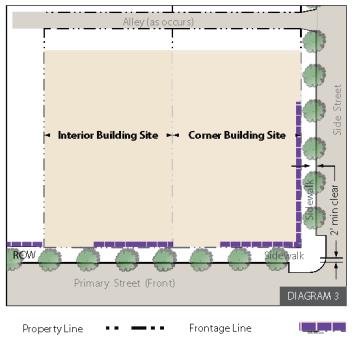
(1) Using only the allowed frontage types, buildings shall incorporate one or multiple frontage types with facades extending along frontage lines per Diagram 3.
(2) Buildings and their additions shall be designed to coordinate the ground floor level with the requirements for frontage in this subsection.
(3) Buildings may incorporate multiple frontage types, as allowed by Sections 18.43.230 to 18.43.270, subject to design review.
(4) Building elements may encroach into setbacks as allowed by the FMC.
(5) Landscaping shall be provided along frontages per the applicable frontage type requirements in Sections 18.43.230 to 18.43.270.
|
Percent of Ground Floor Facade Required in Build-to-Layer |
|
|---|---|
|
Frontage Location |
Min. Beginning from Nearest Street Corner or Building Side Corner |
|
Along Primary Street |
75 |
|
Along Side Street |
65 |
|
Allowed Frontages |
|
|
Shopfront (when within 50 ft of street corner) |
See Table 18.43.220 |
|
Forecourt |
See Table 18.43.220 |
|
Terrace |
See Table 18.43.220 |
|
Stoop |
See Table 18.43.220 |
|
EI Encroachment along rear |
Per FMC |
(i) Parking Placement and Access.
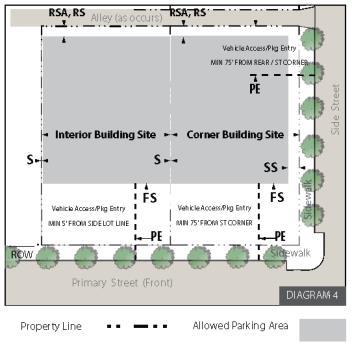
(1) Parking shall be located as shown in Diagram 4. To the extent practical, utilities shall be underground and/or in alleys.
(2) Parking and service areas shall only be accessed from a primary street if an alley or side street are not present.
(3) Parking entries shall not exceed 20 feet in width and shall be designed as integral, decorative components of the building facade.
|
|
MIN. |
SCREENING REQMT. |
|
|---|---|---|---|
|
FS |
Front Setback |
50' |
By the building |
|
RSA |
5' |
By the building, or min. 2' tall decorative wall or hedge when within 10' of side street |
|
|
RS |
10' |
None, except when adjacent to residential, then min. 5' tall wall or fence |
|
|
SS |
Side Street Setback |
10' |
Min. 2' to 4' tall decorative wall or vine hedge |
|
S |
Side Setback |
0' |
None, except when adjacent to residential, then min. 5' tall decorative wall or fence |
|
PE |
Parking Entry |
Corner lot: min. 75' from street corner Interior lot: within 5' of either side when side street or alley are not present |
|
(Ord. 15-2015 § 2 (Exh. B), 6-2-15.)
18.43.100 Development standards – Urban office zone (“UO”).
(a) Intent and Purpose. The urban office (“UO”) zone is generally applied to areas northeast of Paseo Padre Parkway and southwest of the Fremont BART Station to provide a core of health care-oriented employment, services and commercial office/retail uses in support of the hospitals and other medical activities, and to generate the urban fabric that will connect the transit station area to downtown.
(b) Intended Physical Character – Buildings, Frontages. Buildings are block-form and up to 10 stories by expressing a streetwall of up to five stories and tower-form volumes for stories six to 10. Buildings are mixed and single use with the widest variety and most intense commercial uses/services in the city center outside of downtown. Buildings are near or at the sidewalk to spatially define the streetscape. Massing is toward the front of buildings to spatially define the wide streets, provide service areas in the rear, and promote compatibility with neighboring properties.
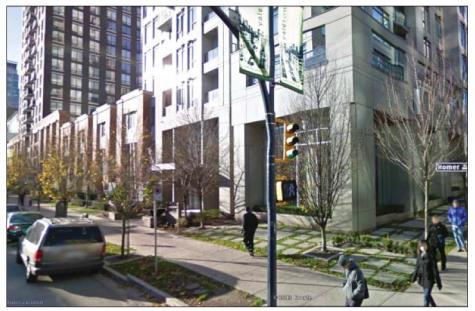
Mixed-use multi-story buildings at or near the sidewalk with service, office and retail on ground floors. Upper stories are massed as tower volumes to maximize views while generating an intense city center streetwall.
(c) Streetscape/Public Realm and Open Space. The streetscape is in support of high pedestrian activity and consists of a range of frontages such as shopfronts with wide awnings and shade trees, forecourts, and parking courts on side streets.
Wide sidewalks accommodate outdoor dining while providing for comfortable strolling and easy view of retail merchandise. Signage supports the urban environment and variety of business activity. Open spaces are urban and provide community gathering space in support of high pedestrian activity and civic events.
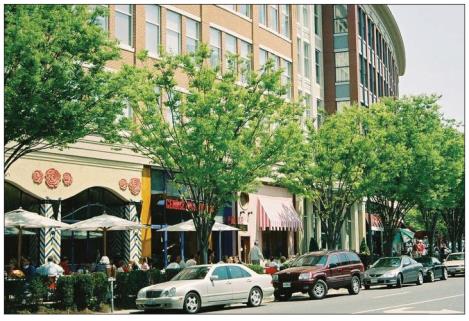
Retail and restaurants of intense buildings connect the BART Transit Station and the downtown.
(d) Land Use Activity. Land use activity consists of a vibrant range from hospitals, medical office, office, retail, restaurants, grocery, bakery/deli, personal services, housing and lodging.
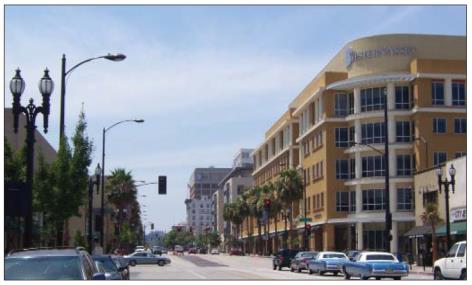
Buildings vary in size with some as large as a block containing medical offices and/or housing above.
(e) Parking. Parking is grouped and shared, including on-street parking, as practical to avoid occupying unnecessary amounts of land with parking. Parking is located on site or remotely, as allowed.
(f) Building Placement.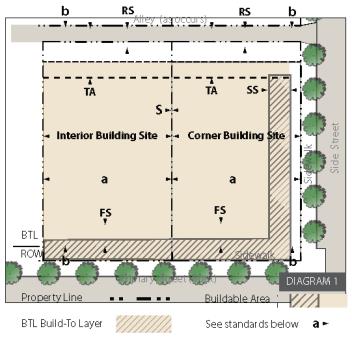
(1) One building shall be located within each building site per Diagram 1. One parcel may have several building sites per the standards below.
(2) Building facades along streets shall be located within the build-to-layer per Diagram 1.
(3) Building facades shall extend along the frontages of the building site per subsection (h) of this section of these requirements.
(4) Projects with at least 20,000 square feet of building site area shall provide at least 15 percent on-site public and semipublic open space per Section 18.43.070(b). Residential projects shall provide private open space per Section 18.43.070(b)(2).
|
Requirement |
MIN. |
MAX. |
|
|---|---|---|---|
|
a |
Building site width |
75' |
400' |
|
b |
Building site depth |
100' |
400' |
|
FS |
Front setback |
0' |
10' |
|
SS |
Side street setback (0 ft within 50 ft of corner) |
10' |
15' |
|
S |
Side setback1 |
0' |
n.a. |
|
RS |
Rear setback2 |
10' |
n.a. |
|
TA |
Setback within code boundary transition area per Figure 18.43.050 |
100': stories 4 through 10 |
|
1 Fire code – Building protection per local fire/safety code.
2 Where an alley provides vehicular access, minimum setback is five feet.
(g) Building Height and Massing.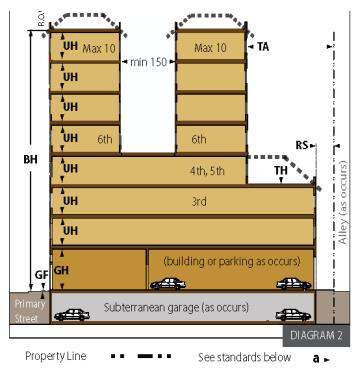
(1) Buildings shall comply with the standards table below, measured in stories and feet.
(2) For every 100 feet of building length, there shall be a plane-break along the facade comprised of an offset of at least five feet in depth by 25 feet in length. The offset shall extend from grade to the highest story. Stories six through 10 shall be expressed as towers at least 150 feet apart. The maximum floor area for each story within a tower shall be approximately 10,000 square feet. These towers need not be rectangular, but may be designed to be of a variety of shapes or forms. Towers within 80 feet of a building edge shall be designed as distinct vertical forms from grade to the highest story.
|
Requirement |
|
MIN. |
MAX. |
|
|---|---|---|---|---|
|
BH |
Building Height: Stories and Feet |
no min. |
10/1201 |
|
|
TH |
Building Height within the Code Boundary Transition Area per Figure 18.43.050 |
no min. |
3/36 |
|
|
GF |
Ground Floor Level above grade: |
nonresidential |
0' |
4' |
|
residential |
2' |
6' |
||
|
GH |
Height of Ground Floor |
16' |
none |
|
|
UH |
Height of Upper Story |
10' |
none |
|
|
TA |
Setback within Code Boundary Transition Area per Figure 18.43.050 |
100': stories 4 through 10 |
||
1 See Chapter 18.250 for the process and requirements to request increases in allowed building height. Architectural elements such as roofs, parapets, and finials are allowed up to 145 feet.
(h) Frontages and Encroachments.
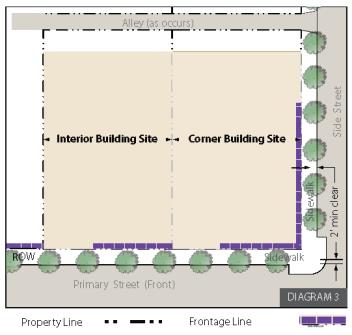
(1) Using only the allowed frontage types, buildings shall incorporate one or multiple frontage types with facades extending along frontage lines per Diagram 3.
(2) Buildings and their additions shall be designed to coordinate the ground floor level with the requirements for frontage in this subsection.
(3) Buildings may incorporate multiple frontage types, as allowed by Sections 18.43.230 to 18.43.270, subject to design review.
(4) Building elements may encroach into setbacks as allowed by the FMC.
(5) Landscaping shall be provided along frontages per the applicable frontage type requirements in Article 4.
|
PERCENT OF GROUND FLOOR FACADE REQUIRED IN BUILD-TO-LAYER |
||
|---|---|---|
|
Frontage Location |
Min. beginning from nearest street corner or building side corner |
|
|
Along primary street |
85 |
|
|
Along side street |
75 |
|
|
Allowed frontages |
||
|
Shopfront |
See Table 18.43.220 |
|
|
Forecourt |
See Table 18.43.220 |
|
|
Parking court (only on side street frontages; not on Paseo Padre) |
See Table 18.43.220 |
|
|
EI |
Encroachment along rear |
Per FMC |
(i) Parking Placement and Access.
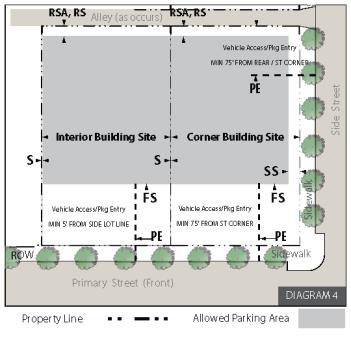
(1) Parking shall be located as shown in Diagram 4. To the extent practical, utilities shall be underground and/or in alleys.
(2) Parking and service areas shall only be accessed from a primary street if an alley or side street are not present.
(3) Parking entries shall not exceed 26 feet in width and shall be designed as integral, decorative components of the building facade.
|
|
|
MIN. |
SCREENING REQUIREMENT |
|---|---|---|---|
|
FS |
Front Setback |
50' |
By the building |
|
RSA |
5' |
By the building, or min. 2' tall decorative wall or hedge when within 10' of side street |
|
|
RS |
10' |
None, except when adjacent to residential, then min. 5' tall wall or fence |
|
|
SS |
Side Street Setback |
10' |
Min. 2' to 4' tall decorative wall or vine hedge |
|
3' |
|||
|
S |
Side Setback |
0' |
None, except when adjacent to residential, then min. 5' tall decorative wall or fence |
|
PE |
Parking Entry |
Corner lot: min. 75' from street corner Interior lot: within 5' of either side when side street or alley are not present |
|
(Ord. 15-2015 § 2 (Exh. B), 6-2-15.)
18.43.110 Development standards – Urban neighborhood zone (“UN”).
(a) Intent and Purpose. The “UN” zone is applied to areas generally west and south of the downtown to support the downtown and employment core areas with a wide variety of housing opportunities, neighborhood services, office, neighborhood retail, and regional retail at The Hub shopping center.
(b) Intended Physical Character – Buildings, Frontages. Buildings are a combination of primarily block-form with some house-form buildings along transitions to existing neighborhoods. Buildings are up to six stories, mixed and single use, with a variety of commercial uses and services. Buildings are near or at the sidewalk to spatially define the streetscape. Massing is toward the front of buildings to spatially define the wide streets, provide service area in the rear, and promote compatibility with neighboring properties.
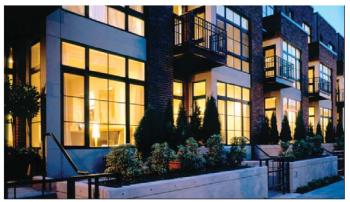
Mixed- or single-use, two- to six-story buildings at or near the sidewalk with residential frontages to share the streetscape and for comfort of ground floor dwelling.
(c) Streetscape/Public Realm and Open Space. The streetscape is in support of pedestrian activity and consists of a range of frontages such as shopfronts with wide awnings near some corners and forecourts, terraces, stoops, and parking courts. Wide sidewalks provide for comfortable strolling and easy view of retail merchandise where shopfronts are allowed. Signage is in support of the wide variety of business activity in these areas. Open spaces are urban and provide community gathering space in support of high pedestrian activity and civic events.
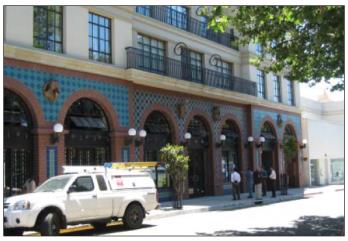
Housing can occupy upper floors with ground floors also with dwellings, services or retail when within 100 feet of a street corner.
(d) Land Use Activity. Land use activity consists of a range of housing choices with limited supporting retail, restaurant, and service activity. In the shopping center known as “The Hub,” nonresidential activity is vibrant and ranges from general retail, restaurants, grocery, bakery/deli, to office and personal services.
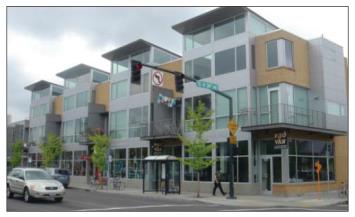
Transitional housing forms such as single- or mixed-use townhouses and/or lofts provide this zone with the widest variety of choices of the three city center zones.
(e) Parking. Nonresidential parking is minimal and grouped to be shared as practical, including on-street parking.
Residential parking is provided on the site of its building or remotely, as allowed.
(f) Building Placement.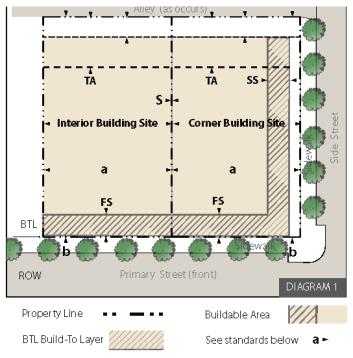
(1) One building shall be located within each building site per Diagram 1. One parcel may have several building sites per the standards below.
(2) Building facades along streets shall be located within the build-to-layer per Diagram 1.
(3) Building facades shall extend along the frontages of the building site per subsection (h) of this section of these requirements.
(4) Projects with at least 20,000 square feet of building site area shall provide at least 15 percent on-site public and semipublic open space per Section 18.43.070(b). Residential projects shall provide private open space per Section 18.43.070(b)(2).
|
REQUIREMENT |
MIN |
MAX |
|
|---|---|---|---|
|
a |
Building site width |
200' |
400' |
|
b |
Building site depth |
100' |
400' |
|
FS |
Front setback (0 ft within 100 ft of corner) |
0' or 10' |
15' |
|
SS |
Side street setback (0 ft within 50 ft of corner) |
10' |
15' |
|
S |
Side setback1 |
0' |
n.a. |
|
RS |
Rear setback2 |
10' |
n.a. |
|
TA |
Setback within code boundary transition area per Figure 18.43.050 |
100': stories 4 through 6 |
|
1 Fire code – Building protection per local fire/safety code.
2 Where an alley provides vehicular access, minimum setback is five feet.
(g) Building Height and Massing.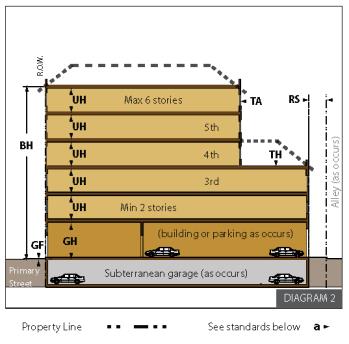
(1) Buildings shall comply with the standards table below, measured in stories and feet.
(2) For every 100 feet of building length, there shall be a plane-break along the facade comprised of an offset of at least five feet in depth by 25 feet in length. The offset shall extend from grade to the highest story.
|
REQUIREMENT |
MIN |
MAX |
||
|---|---|---|---|---|
|
BH |
Building height: stories and feet |
2/25 |
6/751 |
|
|
TH |
Building height within the code boundary transition area per Figure 18.43.050 |
no min. |
3/36 |
|
|
GF |
Ground floor level above grade: |
nonresidential |
0' |
4' |
|
residential |
18" |
6' |
||
|
GH |
Height of ground floor |
16' |
none |
|
|
UH |
Height of upper story |
10' |
none |
|
1 See Chapter 18.250 for the process and requirements to request increases in allowed building height. Architectural elements such as roofs, parapets and finials are allowed up to 110 feet.
(h) Frontages and Encroachments.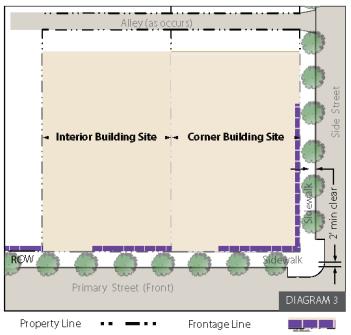
(1) Using only the allowed frontage types, buildings shall incorporate one or multiple frontage types with facades extending along frontage lines per Diagram 3.
(2) Buildings and their additions shall be designed to coordinate the ground floor level with the requirements for frontage in this subsection.
(3) Buildings may incorporate multiple frontage types, as allowed by Sections 18.43.230 to 18.43.270, subject to design review.
(4) Building elements may encroach into setbacks as allowed by the FMC.
(5) Landscaping shall be provided along frontages per the applicable frontage type requirements in Sections 18.43.230 to 18.43.270.
|
Percent of ground floor facade required in build-to-layer |
|
|---|---|
|
FRONTAGE LOCATION |
Min. beginning from nearest street corner or building side corner |
|
Along primary street |
75 |
|
Along side street |
65 |
|
ALLOWED FRONTAGES |
|
|
Shopfront (when within 100 ft of street corner) |
See Table 18.43.220 |
|
Forecourt |
See Table 18.43.220 |
|
Terrace (1) |
See Table 18.43.220 |
|
Stoop (1) |
See Table 18.43.220 |
|
Parking Court (not on Paseo Padre) |
See Table 18.43.220 |
|
(1) Not allowed on Paseo Padre, Civic Center, Fremont |
|
|
EI ENCROACHMENT ALONG REAR |
Per FMC |
(i) Parking Placement and Access.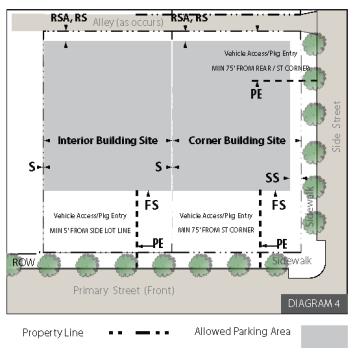
(1) Parking shall be located as shown in Diagram 4. To the extent practical, utilities shall be underground and/or in alleys.
(2) Parking and service areas shall only be accessed from a primary street if an alley or side street are not present.
(3) Parking entries shall not exceed 20 feet in width and shall be designed as integral, decorative components of the building facade.
|
|
|
MIN |
SCREENING REQUIREMENT |
|---|---|---|---|
|
FS |
Front Setback |
50' |
By the building |
|
RSA |
5' |
By the building, or min. 2' tall decorative wall or hedge when within 10' of side street |
|
|
RS |
10' |
None, except when adjacent to residential, then min. 5' tall wall or fence |
|
|
SS |
Side Street Setback |
10' |
Min. 2' to 4' tall decorative wall or vine hedge |
|
7' |
|||
|
S |
Side Setback |
0' |
None, except when adjacent to residential, then min. 5' tall decorative wall or fence |
|
PE |
Parking Entry |
Corner lot: min. 75' from street corner Interior lot: within 5' of either side when side street or alley are not present |
|
(Ord. 15-2015 § 2 (Exh. B), 6-2-15.)
18.43.120 Allowed land uses and permit requirements within city center zoning districts.
(a) Use Table. Table 18.43.120 sets forth those uses which are permitted, conditionally permitted, or prohibited in city center zoning districts. The following terms are used in Table 18.43.120:
(1) Permitted (“P”) uses are allowed subject to conformance to standards or conditions of this title.
(2) Conditional (“C”) uses may be permitted with a conditional use permit, provided all other requirements of this title are met.
(3) Zoning administrator (“Z”) uses may be permitted with a zoning administrator permit, provided all other requirements of this title are met.
(4) Accessory (“A”) uses are allowed when subordinate to or part of a principal use on the same lot and serve as a use incidental to such principal use.
(5) The symbol “--” indicates a use is prohibited within the zoning district.
(b) Permitting Procedures. Permitting procedures for a conditional use permit and zoning administrator permit shall be as provided in Chapters 18.230 and 18.275, respectively.
|
Use |
2012 NAICS2 |
Zones |
Specific Use Requirements/ Notes |
||
|---|---|---|---|---|---|
|
CC-TN |
CC-UO |
CC-UN |
|||
|
Urban agriculture, low-impact1 |
|
P |
P |
P |
Section 18.190.015 |
|
Urban agriculture, high-impact1 |
|
Z |
Z |
Z |
Section 18.190.015 |
|
Assembly, Entertainment, Recreation |
|||||
|
|
-- |
C |
-- |
Sections 18.190.025 and 18.190.140 |
|
|
Club, lodge, meeting hall, or membership organization |
|
-- |
Z |
Z |
Sections 18.190.025 and 18.190.050 |
|
Exhibition and conference halls1 not associated with full service hotels1 |
|
-- |
Z |
Z |
Section 18.190.025 |
|
Fitness and recreational sports centers |
-- |
P3 |
P3 |
Includes yoga and pilates studios. See educational services section for sports and recreation instruction (e.g., dance, martial arts, etc.) |
|
|
Game or computing arcade1, more than five gaming devices |
|
-- |
Z |
Z |
Section 18.190.180 |
|
Assembly uses1 not listed elsewhere including: cultural institutions, libraries, museums, religious facilities, etc. |
|
Z |
Z |
Z |
Section 18.190.025 |
|
Indoor commercial recreation1 including: billiard hall, bowling alley, gymnasia, indoor tennis, swimming, etc. |
|
-- |
C |
C |
Section 18.190.420; Chapter 5.90 applies to swimming facilities; See educational services section for sports and recreation instruction (e.g., dance, martial arts, etc.) |
|
Parks, public |
|
P |
P |
P |
|
|
Place of entertainment1, not elsewhere listed in this table |
|
-- |
Z |
Z |
Chapter 5.45 and Section 18.190.025 |
|
Nightclubs1 and dance clubs1 |
|
-- |
C |
-- |
Chapter 5.45 and Section 18.190.025 |
|
Theater and performance venues, including: concert hall1, dinner theater1, motion picture theater1, or performing arts theater1 |
|
-- |
Z |
Z |
Chapter 5.45 and Section 18.190.025 |
|
Automotive and Transportation |
|||||
|
Automotive repair services, major1 or minor1 |
|
-- |
-- |
-- |
|
|
Automotive parts and accessories stores |
-- |
P3 |
P3 |
Section 18.190.027 |
|
|
Auto sales and dealerships, including motorcycles |
|
-- |
-- |
-- |
|
|
|
-- |
-- |
C |
Section 18.190.027 |
|
|
Parking lots or structures, commercial |
|
P |
P |
P |
|
|
Passenger car rental and leasing and sales with no more than four cars stored on an exterior grade level parking area |
|
Z |
Z |
Z |
Section 18.190.027 |
|
Eating and Drinking |
|||||
|
Drinking place1/brew pub/wine tasting |
|
-- |
Z |
Z |
|
|
|
|
|
|
|
|
|
In general (no restrictions on hours of operation) |
|
P |
P |
P |
Section 18.190.140 |
|
|
-- |
-- |
-- |
|
|
|
With housing above |
|
P |
P |
P |
Section 18.190.140 |
|
With sidewalk dining |
|
P |
P |
P |
When operated in conformance with Section 18.190.510(d), (e) and (f) |
|
Eating place with alcoholic beverages1 |
|
|
|
|
|
|
Closed before midnight |
|
P |
P |
P |
Section 18.190.140 |
|
Open after midnight |
|
-- |
Z |
Z |
Section 18.190.140 |
|
With housing above |
|
Z |
Z |
Z |
Section 18.190.140 |
|
With sidewalk dining |
|
Z |
Z |
Z |
Section 18.190.510 |
|
Educational Services |
|||||
|
Educational services |
-- |
Z |
Z |
See assembly, entertainment, recreation section for yoga and pilates studios |
|
|
Health Care and Social Assistance |
|||||
|
Continuing care retirement communities1 and residential care facilities for the elderly1 |
|
-- |
C |
C |
Section 18.190.026 |
|
Day care, child1 |
|
P |
C |
C |
Section 18.190.400 |
|
|
P |
C |
C |
Not including residential care facilities |
|
|
Health care and social assistance, not elsewhere listed in this table |
|
-- |
Z |
Z |
|
|
Hospitals |
-- |
C |
C |
|
|
|
Medical clinics, convenience1 |
-- |
A |
A |
|
|
|
Nursing care facilities (skilled nursing facilities) |
-- |
C |
C |
|
|
|
Residential intellectual and developmental disability, mental health, and substance abuse facilities |
(6232) |
-- |
-- |
C |
|
|
|
-- |
C |
C |
Section 18.190.026 |
|
|
Office |
|||||
|
|
P |
P |
P |
|
|
|
Offices of physicians, dentists, chiropractors2, optometrists2, podiatrists2, mental health practitioners2, physical, occupational and speech therapists and audiologists2, and acupuncturists |
-- |
P |
P |
|
|
|
Offices, other |
|
P |
P |
P |
|
|
Banks and credit unions (without drive-through1) |
|
P |
P |
P |
|
|
Residential |
|||||
|
|
P |
P |
P |
Section 18.190.150 |
|
|
|
P3 |
P3 |
P3 |
Section 18.190.290 |
|
|
|
P |
P |
P |
Section 18.190.295 |
|
|
Multifamily including units within mixed-use1 buildings excluding townhouse1, listed below |
|
P |
P |
P |
Detached units not allowed |
|
|
P |
P |
P |
Section 18.190.465 |
|
|
Supportive1 and/or transitional housing1 |
|
P |
P |
P |
Section 18.190.527 |
|
|
Z |
Z |
Z |
Detached units not allowed |
|
|
Retail without Drive-In or Drive-Through Enterprise1 |
|
||||
|
Commercial nurseries1 |
|
-- |
-- |
-- |
|
|
Food and beverage stores |
|
|
|
|
|
|
Convenience food stores1 and mini-marts |
P3(*)(**) |
P3(*) |
P3(*) |
(*) Zoning administrator permit if in a project that includes housing above store (**) Only those where the use occupies <5,000 square feet |
|
|
Grocery, supermarket, or specialty food store |
P3(*)(**) |
P3(*) |
P3(*) |
(*) Zoning administrator permit if in a project that includes housing above store (**) Only those where the use occupies <5,000 square feet |
|
|
Furniture, home furnishings and equipment, including carpeting, tile, lighting, bedding, household appliances, and similar uses |
|
-- |
P3 |
P3 |
|
|
Hardware and home improvement stores |
|
|
|
|
|
|
With outdoor storage |
|
-- |
-- |
-- |
|
|
No outdoor storage |
|
-- |
P |
P |
|
|
Health and personal care stores, including pharmacies |
P |
P(*) |
P(*) |
(*) Drive-through1 pharmacies may be permitted when the drive-through is not located between a public sidewalk and a building Section 18.190.110 |
|
|
Liquor stores |
P(*) |
P |
P |
|
|
|
Retail sales, general, including apparel, accessories, books, consumer electronics, consumer goods, flower and gift shops, office supplies, pet supplies, sporting goods, variety stores, and miscellaneous retail, excluding uses classified as “restricted retail” below |
|
P(*) |
P |
P |
(*) Only those where the use occupies <5,000 square feet |
|
Retail sales, restricted: |
|
|
|
|
|
|
Adult-oriented businesses1, not including sexual encounter establishments1 |
|
-- |
C |
C |
|
|
Firearms dealers1 and gunsmiths1, including firearm sales accessory to sporting goods store |
|
-- |
-- |
-- |
|
|
|
-- |
C |
C |
Section 18.190.210 |
|
|
Pawn shops |
|
-- |
C |
C |
|
|
|
-- |
-- |
-- |
|
|
|
Used merchandise or secondhand sales |
|
-- |
Z |
Z |
Section 18.190.430(b) regarding donation/drop off |
|
Services |
|||||
|
Animal care and services |
|
|
|
|
|
|
Boarding and dog day care with outdoor area |
|
-- |
-- |
-- |
|
|
Boarding and dog day care, indoor only |
|
-- |
-- |
Z(*) |
Section 18.190.590; (*) indoor boarding not allowed within mixed-use buildings or adjacent to residential uses |
|
Grooming |
|
-- |
-- |
P |
|
|
Veterinary clinics and animal hospitals |
|
-- |
Z(*) |
Z(*) |
|
|
Artisan and craft shops, such as taxidermists, carpenters, cabinet makers, art studios |
|
P |
P |
P |
|
|
Astrology1 services |
|
-- |
-- |
-- |
|
|
Consumer product repair and maintenance when accessory to an allowable retail use, including repair and servicing of bicycles, cameras, electronics, jewelry, leather goods, and similar products and services |
|
A |
A |
A |
|
|
Hotels, full service1, including conference |
|
C |
Z |
Z |
|
|
Hotels, limited service1; motels |
|
C |
Z |
Z |
|
|
Laundry and dry cleaning services without on-site dry cleaning, coin-operated laundries, and garment services |
|
P |
P |
P |
|
|
Machinery and equipment rental and leasing |
|
-- |
-- |
-- |
|
|
|
C |
C |
C |
Chapter 5.65 and Section 18.190.310 |
|
|
|
P |
P |
P |
|
|
|
|
-- |
C |
C |
|
|
|
Printing, publishing, and photofinishing |
P3 |
P3 |
P3 |
|
|
|
Public or quasi-public use1, not including: corporation/contractor/fleet/service yards1 and warehouses1 or any use specifically listed in this table as a permitted, zoning administrator or prohibited use |
|
C |
C |
C |
|
|
Radio and television broadcasting |
P-UFO |
P3 |
P3 |
|
|
|
Services that have a retail storefront including: locksmiths, postal services, real estate, travel agencies, etc. |
|
P3 |
P3 |
P3 |
|
|
Miscellaneous/Other Uses |
|||||
|
Accessory uses and buildings customarily appurtenant to a permitted use, such as incidental storage facilities |
|
A |
A |
A |
|
|
Any other use that the zoning administrator finds is similar in nature, function, and operation to other: |
|
|
|
|
|
|
Conditional uses in the district |
|
C |
C |
C |
Chapter 18.250 |
|
Permitted uses within the district |
|
P |
P |
P |
Chapter 18.250 |
|
|
Z |
Z |
Z |
Chapter 18.250 |
|
|
|
-- |
-- |
-- |
|
|
|
Structured parking facility, public or commercial1 |
|
C |
P |
P |
|
|
Wireless facilities |
|
|
|
|
Chapter 18.187 |
|
Accessory uses and accessory structures customarily appurtenant to the principal use of property |
|
A |
A |
A |
Chapter 18.153 |
|
Electric vehicle charging stations |
|
A |
A |
A |
|
|
|
A |
A |
A |
Section 18.190.240 |
|
|
Mobile vending vehicle/cart1 |
|
A |
A |
A |
Section 5.35.110 |
|
Outdoor sales and service activities that are accessory to a permitted use or are specifically permitted in the district |
|
-- |
A |
A |
|
|
Small recycling collection facilities1 and reverse vending machines |
|
-- |
A(*) |
A(*) |
Section 18.190.430(a) and (b); (*) not permitted in mixed-use buildings or adjacent residential uses |
|
|
-- |
-- |
-- |
Section 18.190.520 |
|
|
Supportive services for on-site supportive housing1 |
|
A |
A |
A |
Section 18.190.527 |
1 This term is defined in Chapter 18.25.
2 When this column includes a number, the use is elaborated on in the North American Industrial Classification System (NAICS) Manual. When a NAICS number is shown within parentheses, the use is excluded and prohibited.
3 A storefront review certificate or discretionary design review permit is required under Section 18.190.525.
4 A home occupation permit is required in accordance with Section 18.190.240.
(Ord. 15-2015 § 2 (Exh. B), 6-2-15; Ord. 24-2015 § 2, 12-15-15; Ord. 04-2016 § 9 (Att. 1), 3-1-16; amended by city during April 2016 update; Ord. 17-2016 § 10, 9-13-16; Ord. 27-2016 § 8, 12-6-16; Ord. 09-2017 § 3, 6-6-17; Ord. 23-2018 § 5, 10-2-18; Ord. 02-2020 § 9, 1-14-20; Ord. 05-2021 § 13, 4-20-21; Ord. 07-2023 § 11, 12-5-23.)
18.43.130 Parking standards.
(a) Minimum Parking Required. Required parking may be located off site up to 600 feet from the site for residential parking and up to 1,250 feet from the site for nonresidential parking when:
(1) The remote parking complies with the site requirements of the zone; and
(2) The applicant provides the city with a valid off-site parking agreement pursuant to Section 18.183.070 stating that the owner of the remote site authorizes such activity. Shared parking is permitted, but not required, as part of the off-site parking agreement. When shared parking is not part of the off-site parking agreement, exclusive use parking shall be required at a minimum and up to the maximum as provided in Tables 18.43.130(a) and 18.43.130(b).
|
Type of Use |
Minimum |
Minimum |
Maximum |
|---|---|---|---|
|
1 space/5 seats |
1 space/4 seats |
1 space/3 seats |
|
|
Commercial Uses (nonhealthcare) |
2.25 spaces/tgsf |
3.3 spaces/tgsf |
5 spaces/tgsf |
|
Healthcare Uses |
3.3 spaces/tgsf |
4 spaces/tgsf |
5 spaces/tgsf |
|
Residential Uses |
0.75 space/dwelling unit |
1 space/dwelling unit |
2 spaces/dwelling unit |
|
Type of Use |
Minimum |
Minimum |
Maximum |
|---|---|---|---|
|
Commercial Uses (nonhealthcare) |
1.5 spaces/tgsf |
2 spaces/tgsf |
3.3 spaces/tgsf |
|
Residential Uses |
0.50 space/dwelling unit |
0.75 space/dwelling unit |
1 space/dwelling unit |
Note: “tgsf” = thousand gross square feet
(b) Minimum Parking Not Required.
(1) No minimum parking is required on Bay Area Rapid Transit (BART) district-owned parcels that are subject to the TOD zoning standards in Cal. Pub. Util. Code §29010.6.
(2) No minimum parking is required for projects that meet the parking exemptions provided in Chapter 18.183. (Ord. 07-2023 § 12, 12-5-23.)
18.43.135 City center district art program.
(a) Purpose and Goals. The purpose of this section is to implement the city center community plan by establishing a city center district art program. It is the intent of the city to create a program designed to promote the arts in the city center district. It is intended that artwork will be installed throughout the district and be a source of pride to the residents of the city and the community life. The program will provide art education and experiences that will spur creativity and economic development by creating a destination that attracts visitors and encourages walking through the streets of the city center district. The program will develop community pride and identity and improve the general welfare and quality of life in the city. The program will promote partnership between business, local government, and private citizens and thereby encourage awareness and enjoyment of art experiences. An increase in the quantity and quality of distinguished works of art will improve and expand the use and value of buildings and facilities and enhance the urban development of the city center district.
(b) City Center District Art Fee Requirement.
(1) Construction Less Than 100,000 Square Feet of Gross Floor Area. In the case of the construction of any building that is less than 100,000 square feet of gross floor area anywhere in the city center district, or the addition of less than 100,000 square feet of gross floor area to an existing building anywhere in the city center district, a city center district art fee shall be paid into the city’s city center district public art fund.
(2) Construction Greater Than 100,000 Square Feet of Gross Floor Area. In the case of the construction of any building of 100,000 square feet of gross floor area or more in the city center district, or the addition of 100,000 square feet or more of gross floor area to any existing building in the city center district, a city center district art fee shall be paid into the city’s city center district public art fund; provided, however, that the developer, in lieu of paying up to 50 percent of the fee, may choose to pay at least half of the city center district art fee into the city center district public art fund, and expend the remaining amount for on-site artwork.
(3) The amount of the fee shall be based on an amount per square foot adopted by resolution of the city council, and subject to an annual escalator (applied at the beginning of each calendar year) based on the Consumer Price Index (CPI) in the San Francisco-Oakland-San Jose area for the preceding year.
(c) Timing of Payment of City Center District Art Fee and Installation of On-Site Artwork. The city center district art fee shall be paid prior to the issuance of the first building permit for the project. The fee may be subject to deferral consistent with city fee deferral policies for development impact fees. For projects where the developer has opted to provide in-lieu on-site artwork, the art shall be installed on the property prior to the issuance of the first certificate of occupancy, unless the community development director grants an extension taking into consideration the size of the artwork, difficulty of manufacturing and/or installation, and related costs while ensuring that the artwork is installed as soon as reasonably feasible.
(d) City Center District Public Art Fund. All fees collected under this section shall be deposited into a segregated fund to be designated the “city center district public art fund.” The fund shall be used for city-owned art or city-sponsored exhibitions located within the boundaries of the city center district. The fund shall be used exclusively to prepare sites for works of art, acquire and install works of art, maintain works of art, support the exhibition of publicly accessible art or fund other administrative costs, including city staff time, associated with the city center district art program. The city will oversee the design and installation of the art in the city center district pursuant to the city’s art in public places policy.
(e) Approval of On-Site Artwork. For projects with construction greater than 100,000 gross square feet of floor area, if the developer has opted to place in-lieu artwork on site, the developer must comply with the process and guidelines promulgated by the community development director for approval, installation and maintenance of on-site artwork. The owner of the real property on which artwork approved under this program is located shall maintain the artwork installed pursuant to this section. The community development director is authorized to approve on-site artwork but may refer proposed artwork to the art review board and/or city council if he or she believes further input and direction is required.
(f) Installation and Maintenance of On-Site Artwork – Enforcement.
(1) Following approval and installation of the artwork, the developer shall record a document with the county recorder setting forth a description of the artwork and stating the obligation of the property owner to repair and maintain the artwork.
(2) At any time the community development director has determined that the artwork has not been installed or maintained in substantial conformance to the manner in which it was originally approved, he or she shall require the current property owner to either:
(A) Install, repair or maintain the artwork; or
(B) Pay the city center district art fee required by subsection (b)(2) of this section, based upon the current fee schedule and the square footage of the building, structure or improvement for which the artwork was required. (Ord. 04-2016 § 10, 3-1-16.)
Article 3. Walkable Block Standards
18.43.140 City center scale, intended physical character streetscapes.
Property and rights-of-way subject to the city center code are intended to generate and support the walkable blocks, streetscapes and city-scale physical character as described below.
(a) Design Objectives. Existing blocks are allowed to remain until any of the requirements of Section 18.43.030(a)(2)(A) apply. New or existing blocks to be modified shall be designed and maintained to:
(1) Support the city center-scale environment of interconnected blocks and streetscapes that facilitate walking and multi-modal access;
(2) Support the intended physical character of the zone; and
(3) Generate blocks per the requirements of the zone and identified in Section 18.43.170.
(b) Applicability. Existing blocks or parcels that do not conform to the requirements of Table 18.43.140 shall be made to conform when any of the criteria in Section 18.43.030(a)(2)(A) apply. In those circumstances, new streets or pedestrian connections shall be applied to the parcel in compliance with the requirements of Table 18.43.140, Block Standards.
(c) Street Standards. Street Standards are identified in the city center community plan.
(d) Block Standards. Table 18.43.140 identifies the requirements for block size in each zone. These standards work in combination with existing streets and intended alignments for new streets as identified in Figure 18.43.050.
New blocks or existing blocks that are to be modified shall comply with the following:
|
ZONE |
TN |
UO |
UN |
|---|---|---|---|
|
Max. Feet |
|||
|
BLOCK PERIMETER |
1,200 |
1,600 |
1,600 |
|
BLOCK LENGTH |
400 |
500 |
400 |
The following requirements apply as required by Section 18.43.030(a)(2)(A):
(1) Blocks shall be made only by applying the applicable street type(s) identified in the city center community plan and per the procedure identified in Figure 18.43.140 (illustrative sequence);
(2) A network of walkable blocks shall be maintained or generated as identified in Figure 18.43.050 and may be modified when consistent with the applicable findings in Section 18.43.160;
(3) The locations of intended street alignments identified in Figure 18.43.050 are approximate and as with existing street alignments, may be moved in either direction in compliance with the block standards in Table 18.43.140 and the applicable findings in Section 18.43.160;
(4) When, after applying an intended street(s), a block still exceeds the maximum block length requirements for the zone, one or more of the streets available as new streets in the community plan shall be applied to the parcel per the requirements of Table 18.43.140;
(5) When new blocks are generated, the zone that previously applied to the parcel shall continue to apply unless the applicant chooses to request another city center zone through a rezoning process under Chapter 18.225.
Figure 18.43.140 Illustrative Sequence of Applying Block Standards to Generate New Block(s)
STEP 1: EXISTING SITE
When required to apply streets to a parcel as identified in Section 18.43.140, the parcel shall be subdivided further to create additional blocks per the requirements of Table 18.43.140. These requirements do not require or prohibit unified ownership.
The example in Figure 18.43.140A shows one zone applying to the existing site to be subdivided into multiple blocks. As the site is subdivided to generate additional blocks, the zoning may need to be adjusted to exclude rights-of-way and correspond to the reconfigured block(s). Refer to Figure 18.43.050 for applicable zoning.
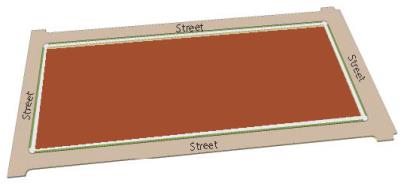
Figure 18.43.140A – Existing Site
STEP 2: APPLY STREETS
Parcels being subdivided to generate additional blocks shall apply streets or pedestrian connections by using one or more of the streets in the city center community plan per the applicable block size requirements of Table 18.43.140 and per Figure 18.43.050 which identifies the approximate location of new streets intended by the city center precise plan.
The actual alignment(s) and street(s) to be applied shall be resolved through the design review process in Chapter 18.235. For existing streets, the location and trajectory may also be adjusted subject to the requirements of Section 18.43.140 and the design review process.
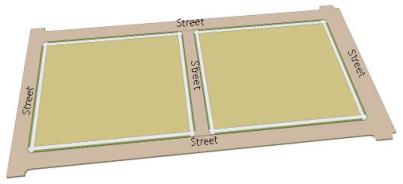
Figure 18.43.140B – Apply Streets
STEP 3: APPLY ALLEYS
Access to new blocks and their individual building sites is allowed primarily by alley or side street, with certain requirements for access via the primary street. Alleys are not intended as additional streets but as service alleys, and shall be up to 20 feet wide. The intent of directing access to the rear or side of building sites is to maintain the continuity of the streetscape without interruptions such as driveway access. Therefore, the introduction of rear service alleys is not required if a building site complies with the zone requirements for front access.
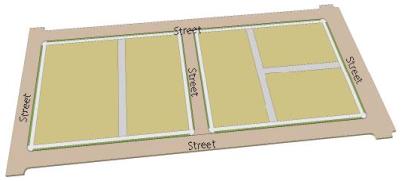
Figure 18.43.140C – Apply Alleys
STEP 4: ADJUST ZONE BOUNDARIES
Upon generating the additional block(s) per Table 18.43.140, it may become desirable or necessary to adjust the existing zone boundaries. In such a case, the adjusted zone(s) or new zone(s) are to be applied to the new block(s) per Section 18.43.140(d)(5).
The example in Figure 18.43.140D shows an additional zone being applied to the reconfigured site: The original zone prior to subdividing the parcel and a second city center zone to allow for a different range of intensity and physical character in response to the new block and street configuration.
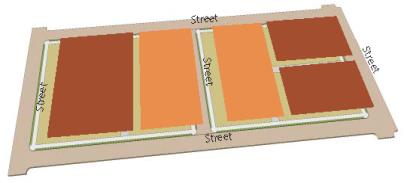
Figure 18.43.140D – Adjust Zone Boundaries and potentially add a new Zone
STEP 5: APPLY BUILDING SITES
After finalizing the blocks and their zoning, building sites are applied on each block to correspond with the pattern and scale allowed by the applicable zone.
Building sites are for the purpose of building design and reflect the minimum to maximum area needed to effectively design one building per building site per the requirements of the zone.
The example in Figure 18.43.140E shows several building sites, each of which complies with the “building site width” and “building site depth” requirements of the zone. A “project application” may consist of one or as many building sites that can fit on each applicant’s parcel within a block per the zone requirements. For example, a new block may have multiple project applications by different applicants while each application helps to incrementally generate the intended physical character of the zone.
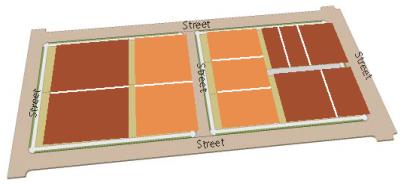
Figure 18.43.140E – Apply Building Sites
STEP 6: APPLY PROJECTS
Each building site is to accommodate one building per the applicable requirements. The building is then designed by the applicant of that building site per the requirements of the zone. Upon concluding the design review process, the actual building site lines are no longer required.
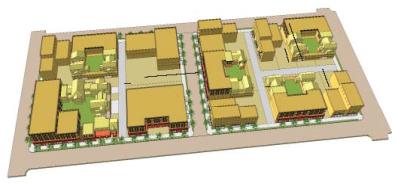
Figure 18.43.140F – Apply Projects
(Ord. 15-2015 § 2 (Exh. B), 6-2-15.)
18.43.150 Street dedications and improvements required.
(a) Required Dedications and Improvements. In order to implement the city center community plan, dedications and improvements may be deemed necessary by the city and may be required as a condition of approval for the project. All dedications and improvements shall be in accordance with Chapter 12.10 (Street Rights-of-Way and Improvements).
(b) Subdivided Parcels. Whenever a parcel is subdivided or when any of the thresholds in Section 18.43.140 apply, public improvements shall be installed on the parcel frontage in compliance with the requirements of this section.
(c) Installation of Streets. When a parcel exceeds the applicable maximum block length in Table 18.43.140 and the application involves any of the scenarios in Section 18.43.140, additional streets are required on the parcel per the following:
(1) In accordance with the general locations for new streets and street types shown on Figure 18.43.050, the applicable street(s) shall be installed as part of the project;
(2) As required by the city, the project shall provide the necessary right(s)-of-way to install its pro rata share of all necessary street improvements. The city shall determine if a street is to be dedicated as a public street or if it will remain as a private street;
(3) The street(s) to be applied to the property shall be from those labeled “New Street” or “Optional as New Street” in the city center community plan subject to the design review process in Chapter 18.235.
(d) Physical Transitions. As required by the city, when a street is improved, the nearest intersection(s) shall be redesigned to correspond with the applicable street requirements from the city center community plan. Improvement plans for each street being improved or installed shall include the proposed design for the involved intersections subject to the city’s review and approval and shall address the following:
(1) When a new building, addition, or other site improvement affects the layout of an existing parking area or the alignment of existing driveway access, the site plan for the new building, addition, or other site improvement shall show how the resulting parking area or driveway access will be reconfigured to be consistent with the zone standards and to provide effective physical transitions between the area(s) being improved and areas not being improved.
(2) When a streetscape is improved on one block and the adjacent blocks are not being improved, the streetscape plan for the project shall show how the physical transition between the improved block and the blocks to remain unimproved is consistent with the standards in Section 18.43.030, subject to the review and approval of the lane-transitions by the city. Such transitions between improved and unimproved blocks may require that the ultimate improvements along the block to be improved may not be able to be installed until such time as the adjacent blocks are proposed for the same improvement(s). In such cases, the streetscape plan for the project shall show the interim improvements and the ultimate improvements.
(e) Standards. All improvements shall comply with the applicable standards and requirements of this article. (Ord. 15-2015 § 2 (Exh. B), 6-2-15.)
18.43.160 Required findings.
In addition to the requirements set forth in Chapter 18.235, the approval authority shall approve or conditionally approve a project subject to this article only when all of the following findings, as applicable, can be made.
The project:
(a) Generates or maintains an interconnected, network of walkable, pedestrian-oriented blocks defined by pedestrian-oriented streets, as shown in Figure 18.43.050 and envisioned in the city center community plan;
(b) Supports public open space corresponding to the intended physical character and role of the adjacent zone(s);
(c) Provides for vehicular and service access to blocks through alleys or as otherwise allowed to maintain a pedestrian-oriented streetscape while adequately servicing individual buildings; and
(d) Complies with the applicable requirements of Figure 18.43.050. (Ord. 15-2015 § 2 (Exh. B), 6-2-15.)
Article 4. Building Frontage Standards
18.43.170 Purpose.
This article establishes the standards for how buildings and sites individually shape the variety of streetscapes in the city center. (Ord. 15-2015 § 2 (Exh. B), 6-2-15.)
18.43.180 Frontages types and standards.
Table 18.43.220 identifies the allowed frontage types and requirements within each zone applied to parcels in Figure 18.43.050. All buildings and sites subject to this code shall be designed, built and maintained per the applicable requirements of Table 18.43.220. (Ord. 15-2015 § 2 (Exh. B), 6-2-15.)
18.43.190 City center-scale frontage.
Property and rights-of-way subject to the city center code are intended to generate and support the city center-scale and physical character for site and building frontage intended by the city center community plan as described below.
(a) Design Objectives. Frontages shall be designed and maintained to:
(1) Support the intended physical environment of the zone;
(2) Support active and continuous pedestrian-oriented environments, per each zone;
(3) Provide a physical transition between the public right-of-way and each building site that shapes the public realm per the intended physical environment of the zone; and
(4) Express creativity in frontage design in compliance with the requirements of this article.
(b) Applicability. Existing parcels and buildings that do not conform to the requirements of this article shall be made to conform to the extent practicable when any of the following apply:
(1) Structural modification of facade and/or storefront that is within 100 feet of the street frontage; and
(2) A new building is proposed.
(c) Incremental Compliance for Existing Sites, Buildings. As provided in Section 18.43.030(a)(2) only the portion(s) involved with a modification are required to comply with the applicable standards.
(d) Intended Physical Character. Each zone in the city center code is for the purpose of generating distinct environments as described in Article 2 that when connected to one another along streetscapes, generate the cohesive city center-scale character envisioned in the city center community plan. The intended physical character as it relates to streetscapes and frontages is described below for each zone.
(1) Transit Neighborhood Zone. Buildings are near or set back from the sidewalk to spatially define the streetscape. Massing is toward the front of buildings to spatially define the streets, provide service area in the rear, and promote compatibility with neighboring properties. The streetscape is in support of pedestrian activity and consists of a range of frontages such as terraces, stoops, as well as shopfronts in limited areas with wide awnings and shade trees. Wide sidewalks provide for comfortable strolling.
(2) Urban Office Zone. Buildings are near or at the sidewalk to spatially define the streetscape. Massing is toward the front of buildings to spatially define the wide streets, provide service area in the rear, and promote compatibility with neighboring properties. The streetscape is in support of high pedestrian activity and consists of a range of frontages with high transparency such as shopfronts with wide awnings and shade trees to forecourts, and parking courts on side streets. Wide sidewalks accommodate outdoor dining while providing for comfortable strolling and easy view of retail merchandise.
(3) Urban Neighborhood Zone. Buildings are near or at the sidewalk to spatially define the streetscape. Massing is toward the front of buildings to spatially define the wide streets, provide service area in the rear, and promote compatibility with neighboring properties. The streetscape is in support of pedestrian activity and consists of a range of frontages such as shopfronts with wide awnings near some corners and forecourts, terraces, stoops, and parking courts on side streets. Wide sidewalks provide for comfortable strolling and easy view of retail merchandise where shopfronts are allowed. (Ord. 15-2015 § 2 (Exh. B), 6-2-15.)
18.43.200 Required findings.
In addition to any requirements set forth in Chapter 18.235, the approval authority shall approve or conditionally approve any project subject to this article only when all of the following findings, as applicable, can be made:
(a) Generates or maintains the pedestrian-oriented streetscape(s) envisioned in the city center community plan through the appropriate design of frontages;
(b) Generates or maintains an appropriate transition from the public streetscape to each building and its site;
(c) Complies with the requirements of the applicable frontage type(s);
(d) Expresses creativity in frontage design per the requirements of Table 18.43.220. (Ord. 15-2015 § 2 (Exh. B), 6-2-15.)
18.43.210 Addition of building frontage type.
(a) Requirements. Applications that propose to add a building frontage type to the city center code shall comply with the requirements of Chapter 18.225. (Ord. 15-2015 § 2 (Exh. B), 6-2-15.)
18.43.220 Requirements by zone.
In support of the purpose and intended physical environment for each zone, Table 18.43.220 identifies the requirements for building frontage types in each zone.
(a) Build-to-Layer. As required by subsection (h), “Frontage and Encroachments,” of the applicable zone, facades shall be located in the identified “build-to-layer” using only the allowed building frontage types.
(b) Multiple Frontage Types. As identified in subsection (b), “Design Standards,” for each frontage type, a site or building may utilize multiple frontage types as allowed by the requirements of the zone and of each type. The actual design of combined types shall be reviewed through a design review permit in accordance with Chapter 18.235.
|
ALLOWED TYPES |
TRANSIT NEIGHBORHOOD |
URBAN OFFICE |
URBAN NEIGHBORHOOD |
|---|---|---|---|
|
|
REQUIREMENTS |
REQUIREMENTS |
REQUIREMENTS |
|
A. SHOPFRONT |
See Section 18.43.2302 |
See Section 18.43.230 |
See Section 18.43.2303 |
|
B. FORECOURT |
See Section 18.43.240 |
See Section 18.43.240 |
See Section 18.43.240 |
|
C. TERRACE |
See Section 18.43.250 |
Not allowed in zone |
See Section 18.43.2501 |
|
D. STOOP |
See Section 18.43.260 |
Not allowed in zone |
See Section 18.43.2601 |
|
E. PARKING COURT |
not allowed in zone |
See Section 18.43.2704 |
See Section 18.43.2704 |
NOTES FOR TABLE 18.43.220:
See Sections 18.43.230 to 18.43.270 – Type allowed in zone, see reference for requirements.
(1) Not allowed on Paseo Padre Parkway, Civic Center Drive, Fremont Boulevard.
(2) Allowed when within 50 feet of street corner.
(3) Allowed when within 100 feet of street corner.
(4) Not allowed on Paseo Padre Parkway.
Allowed Building Frontage Types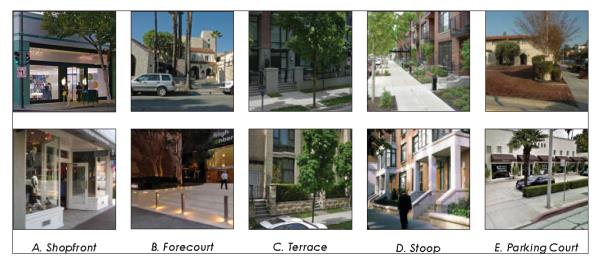
(Ord. 15-2015 § 2 (Exh. B), 6-2-15.)
18.43.230 Shopfront frontage standards.
(a) Description. Shopfront is the frontage type for buildings with ground floor commercial/retail uses. The frontage is made by insertion of large openings filled with transparent windows at the ground level facades. Most or all of the facade is located near or at the property line. The building entrance is at the grade of the sidewalk, and provides direct access to the commercial/retail uses on the ground floor.
The basic architectural elements comprising the storefront are large windows, doors with glass, clerestory glass, and a solid base (bulkhead). Optional elements include awnings, cantilevered shed roof or canopy, signage, lighting, and cornices. Awnings, shed roofs, or canopies may encroach into the public right-of-way and cover the sidewalk within a few feet of the curb, subject to an encroachment permit.
Landscaping may be provided in vine pockets or planter boxes at the building facade as allowed in the applicable zone.
(b) Design Standards.
(1) Shopfront frontages shall be located within the build-to layer for the zone. Other facades may use this frontage type per the applicable requirements.
(2) Individual storefronts shall comply with the height standards to provide adequate view into ground floor spaces.
(3) The horizontal area of the facade that is between two feet and 12 feet from the sidewalk shall contain at least 70 percent storefront glass.
(4) Storefront glass shall be clear without reflective glass, frosting, or dark tinting.
(5) Storefront windows may have clerestory windows between the storefront and second floor/top of single-story parapet. Glass in clerestory windows may be of a character to allow light, while moderating the transparency through such materials as stained glass, glass block, painted or frosted glass.
(6) Storefront bulkhead shall be of material similar or complementary to main materials of the building.
(7) Walls without openings shall not exceed 10 linear feet on primary frontages and 25 linear feet on side streets.
(8) Awning materials and configurations shall comply with the requirements of Section 18.43.020(b)(4) and (5).
(9) Shopfronts may be combined with the following frontage types: forecourt, parking court.
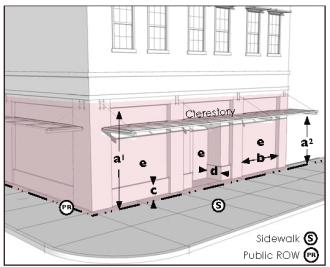
Shopfront diagram – Elements and dimensions combining to make the frontage.
|
SHOPFRONT STANDARDS |
AWNING |
||||
|---|---|---|---|---|---|
|
|
MIN. |
MAX. |
MIN. |
MAX. |
|
|
a1 |
Height (clear) to top of opening |
12' |
22' |
– |
– |
|
a2 |
Height (clear) |
– |
– |
8' |
18' |
|
b |
Width of storefront bay(s) |
8' |
25' |
– |
– |
|
c |
Height of bulkhead |
8" |
42" |
– |
– |
|
d |
Depth of recessed entry |
No min.; 10' max. for up to 25% of facade |
|||
|
e |
Glass area % of ground facade |
70 |
90 |
– |
– |
|
f |
Storefront on second frontage |
25' |
n/a |
– |
– |
Example of Intended Physical Character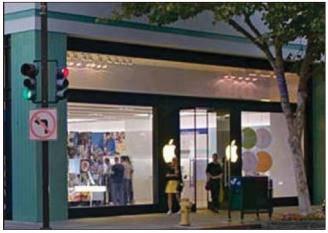
Shopfront example – Large glazing area of display windows, minimal bulkhead under windows, glass door, and shade from nearby street trees.
(Ord. 15-2015 § 2 (Exh. B), 6-2-15.)
18.43.240 Forecourt frontage standards.
(a) Description. The forecourt frontage consists of open or semi-enclosed areas adjacent to the sidewalk made by setting back a portion of the building facade from the front property line. Typically the setback portion is the middle section, which creates a small entry court. This can also be achieved by setting back the facade when a building’s neighboring structures have zero setback at their respective property lines.
Forecourts may be further defined by low walls or landscape between the sidewalk and adjacent property line. Forecourts may be paved with decorative paving subject to city review and approval or they may be landscaped, or a combination. Landscaping may include grasses, small shrubs, and accent trees with sufficiently transparent canopies to allow views of the building facade.
(b) Design Standards.
(1) Forecourt frontages shall be located within the build-to layer for the zone. Other facades may use this frontage type per applicable requirements.
(2) Forecourts may be elevated from the adjacent sidewalk by up to four feet. An elevated forecourt shall meet accessibility requirements for access with the building and the sidewalk. All ramps shall be visually unobtrusive and mounted on walls facing the sidewalk.
(3) Forecourts may be combined with the following frontage types: shopfront, terrace, or stoop. Except however, when used on hotels and commercial buildings, forecourts shall be combined with the shopfront type (Table 18.43.220).
(4) As allowed by the zone, awnings, shed roofs or canopies may encroach into the forecourt for a cumulative one-half of the forecourt width and depth, respectively.
(5) Entry to forecourts may be expressed through a decorative wall or low fence with a gateway; provided, that the wall, fence and gateway are designed as an extension of the immediately adjacent facade.
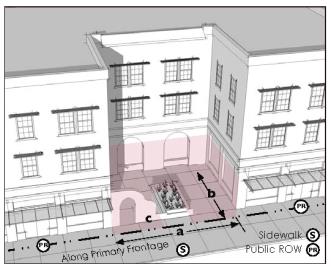
Forecourt diagram – Storefronts combined with an expanded sidewalk that enters the site to generate an open space comprise the frontage.
|
FORECOURT STANDARDS |
|||
|---|---|---|---|
|
|
MIN. |
MAX. |
|
|
a |
Width along primary frontage |
25' |
1/2 primary frontage |
|
b |
Depth perpendicular to primary frontage |
25' |
50' |
|
c |
Wall |
30" |
1 story |
|
d |
12" |
3' |
|
|
e |
Per 18.43.070(b) |
||
Example of Intended Physical Character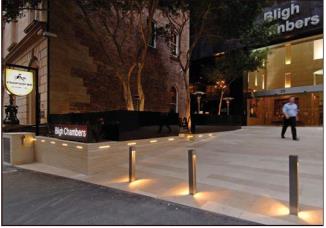
Forecourt example – Ground floor storefronts along sidewalk continue into forecourt visually extending the sidewalk and generating gathering space.
(Ord. 15-2015 § 2 (Exh. B), 6-2-15.)
18.43.250 Terrace frontage standards.
(a) Description. Terrace frontages consist of setting the primary building facade back from the front property line, and placing an elevated garden or terrace in that setback. Terraces are enclosed by a low wall at or near the property line with a stair or ramp from the sidewalk up onto the terrace. Stairs or ramps may serve individual units or may be combined to serve several units. This frontage is effective for “walk-up” housing that is near the street and can benefit from an elevated terrace.
The building activities are slightly separated from the adjacent sidewalk by the terrace height, and the depth of the terrace provides a buffer. The buffer provides clear area distinctions for commercial uses such as dining patios, and provides secure buffers for private yards and residences from public encroachment.
(b) Design Standards.
(1) Terrace frontages shall be located within the build-to layer for the zone. Other facades may use this frontage type per applicable requirements.
(2) Terraces may be enclosed along the sidewalk by decorative low walls or fences. Terraces may have fences to provide for safety.
(3) Terraces may be physically divided from those of adjacent ground floor units through hedges, planters or other vertical landscaping.
(4) The average grade of the terrace shall not be more than four feet above the adjacent sidewalk or public open space.
(5) Walls and/or fences shall be consistent with the architectural style of the building in their design, materials, and finishes.
(6) Terraces may be combined with the following frontage types: forecourt, stoop.
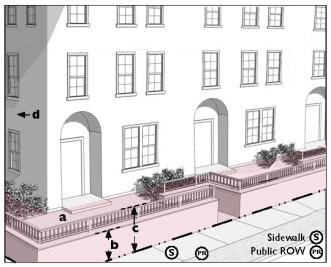
Terrace diagram – Raised yard directly accessible and in front of the building accessed by individual or combined stairs/ramps comprise the frontage.
|
TERRACE STANDARDS |
|||
|---|---|---|---|
|
|
MIN. |
MAX. |
|
|
a |
Size of terrace |
Per building setback |
|
|
b |
Height of terrace from sidewalk |
18" |
4' |
|
c |
Height of wall/fence or hedge from terrace level |
36" |
48" |
|
d |
Openings on secondary frontage |
1 in 25' beginning at front |
|
Example of Intended Physical Character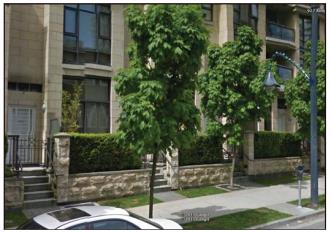
Terrace Example – Each ground floor dwelling in this large building has direct access to the street via a terrace frontage which elevates the ground floor from the urban street while generating outdoor space for the occupants.
(Ord. 15-2015 § 2 (Exh. B), 6-2-15.)
18.43.260 Stoop frontage standards.
(a) Description. Stoops are exterior stairs with landings which provide access to ground floor dwellings located near or at their front property lines. The ground floor of the building is raised to provide some privacy for the rooms facing the public street and passersby. This frontage is effective for “walk-up” housing that is near the street and benefits from clearly separate entries with minimal exterior space.
Landscaping typically flanks the stairs in planters at grade or in decorative containers. Demarcating garden walls are allowed subject to the applicable requirements for height and materials.
(b) Design Standards.
(1) Stoop frontages shall be located within the build-to layer for the zone. Other facades may use this frontage type per applicable requirements.
(2) Stoops shall be of such dimensions to allow for adequate access to the ground floor of the building.
(3) The exterior stairs can be perpendicular or parallel to the adjacent sidewalk. The landing may be covered or uncovered.
(4) Landscaping shall be placed on the sides of the stoop at grade or in raised planters.
(5) Low walls and/or fences may be located within the front and/or side street setbacks when in compliance with all applicable requirements and if the materials and design are compatible with the architectural style of the building.
(6) Stoops may be combined with the following frontage types: forecourt, terrace.
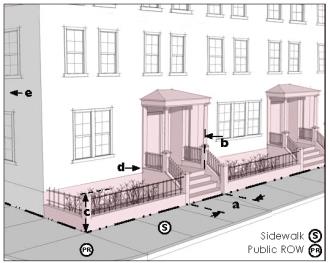
Stoop diagram – Raised individual entry within a small landscaped setback comprises the frontage.
|
STOOP STANDARDS |
|||
|---|---|---|---|
|
|
MIN. |
MAX. |
|
|
a |
Width |
3' |
None |
|
b |
Depth (not including stairs) |
3' |
10' |
|
c |
Wall/fence or hedge |
12" |
4' |
|
d |
Height of stoop from sidewalk |
18" |
6' |
|
e |
Openings on secondary frontage |
1 in 25' |
Beginning of front setback |
Example of Intended Physical Character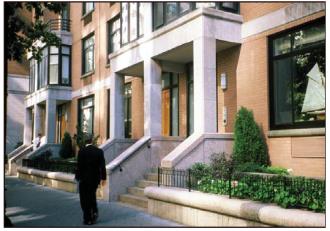
Stoop example – Pairs of stoops with individual stairs, landings and flanking landscape areas.
(Ord. 15-2015 § 2 (Exh. B), 6-2-15.)
18.43.270 Parking court standards.
(a) Description. Parking court frontages are only along side streets and consist of up to half of the side street building facade being set back from the front property line with a small parking lot within the setback. The parking lot is screened or enclosed by a low wall or hedge at or near the property line for visual compatibility with the adjacent streetscape. The wall or hedge includes pedestrian entrances from the sidewalk and vehicular driveways from either the primary or secondary street(s). In order to maintain an urban environment, at least half of the building is near or at the sidewalk along the property line(s).
Landscaping typically separates the low wall from the adjacent sidewalk through planters (raised or at grade) or in decorative containers. When walls are used in lieu of a hedge, the materials and finishes are consistent with those of the primary building on the site.
(b) Design Standards.
(1) Parking court frontages shall be located on the building site as required by the zone. The parking court is the frontage for the building site.
(2) Parking courts shall be designed to provide for safe vehicular and pedestrian access within the intended physical environment.
(3) Parking courts shall have no more than two rows of parking between the building and the street.
(4) Driveways providing ingress and egress to the parking court shall not exceed 20 feet in width and shall have curb radii no larger than 15 feet.
(5) Low walls and/or hedges shall screen the parking along the sidewalk. When walls are used, the materials and design shall be compatible with the architectural style of the building.
(6) Landscaping shall be placed in front of any wall along the front of the parking court and shall be as deep as required by applicable zone standards.
(7) Parking courts may be combined with the following frontage types: shopfront.
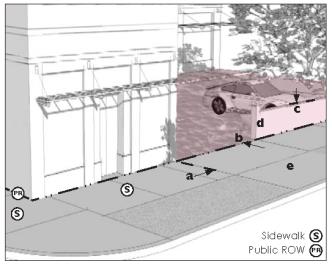
Parking court diagram – Convenience parking within a central area along the frontage that is shaped by portions of the building near or at the sidewalk.
Example of Intended Physical Character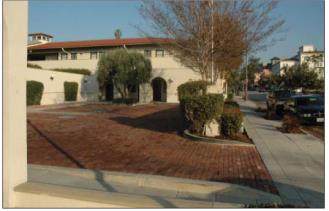
Parking court example – The parking court frontage provides convenience parking in addition to on-street parking for lobbies or other ground floor activities that can benefit from controlled vehicular activity. Note how the parking court is a recess within the overall building that addresses the sidewalk and streetscape.
|
PARKING COURT STANDARDS |
|||
|---|---|---|---|
|
|
MIN. |
MAX. |
|
|
a |
Width along side street frontage |
No min. |
50% |
|
b |
Depth (from sidewalk to building) |
45' |
75' |
|
c |
Height of wall/hedge |
No min. |
4' |
|
d |
Length of wall/hedge |
50% |
clr of dwys |
|
e |
Vehicular access |
Per subsection (i) of zone standards |
|
(Ord. 15-2015 § 2 (Exh. B), 6-2-15.)